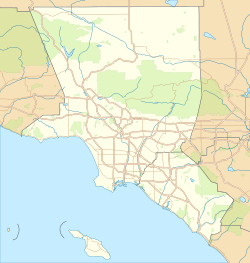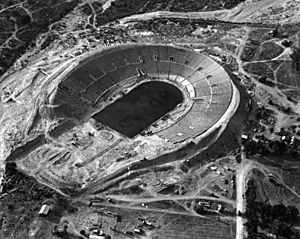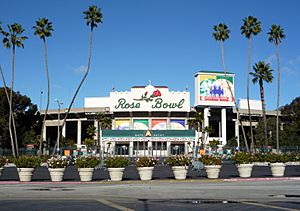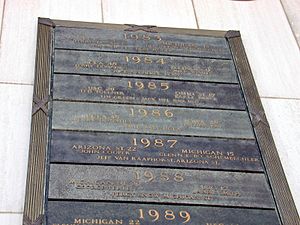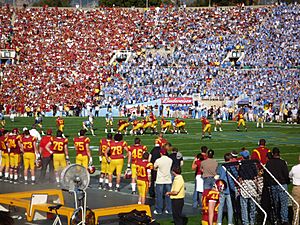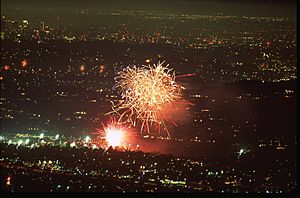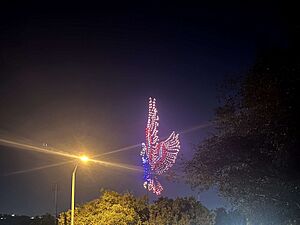Rose Bowl (stadium) facts for kids
|
Spieker Field at the Rose Bowl
America's Stadium |
|
 |
|

Aerial view from south in 2018
|
|
| Address | 1001 Rose Bowl Drive |
|---|---|
| Location | Pasadena, California, United States |
| Coordinates | 34°09′40″N 118°10′05″W / 34.161°N 118.168°W |
| Elevation | 830 feet (255 m) |
| Public transit | |
| Owner | City of Pasadena |
| Operator | Rose Bowl Operating Company |
| Capacity | 89,702 |
| Record attendance | 106,869 (1973 Rose Bowl) |
| Field size | 109.75 m × 48.75 m (360.1 ft × 159.9 ft) |
| Surface | Bermuda grass |
| Construction | |
| Broke ground | 1922 |
| Opened | October 28, 1922 first Rose Bowl game: January 1, 1923 |
| Construction cost | $272,198 ($4.76 million in 2022 ) |
| Architect | Myron Hunt |
| Tenants | |
| Rose Bowl Game (NCAA) 1923–present Caltech Beavers (NCAA) 1923–1976 Loyola Lions (NCAA) 1951 CSULA Diablos 1957–1960, 1963–1969 Los Angeles Wolves (NASL) 1968 Pasadena Bowl 1946–1966, 1969–1971 Los Angeles Aztecs (NASL) 1978–1979 UCLA Bruins (NCAA) 1982–present Los Angeles Galaxy (MLS) 1996–2002, 2023 |
|
|
The Rose Bowl
|
|

Panorama in October 2004, hosting Arizona
|
|
| NRHP reference No. | 87000755 |
| Significant dates | |
| Added to NRHP | February 27, 1987 |
| Designated NHL | February 27, 1987 |
The Rose Bowl is a famous outdoor sports stadium in Pasadena, California, United States. It opened in October 1922. This stadium is recognized as a National Historic Landmark and a California Historic Civil Engineering landmark.
With seats for 89,702 people, the Rose Bowl is one of the largest stadiums in the world. It is the 11th largest in the United States and the 10th largest for college sports. The stadium is about 10 miles (16 km) north of downtown Los Angeles.
The Rose Bowl is most famous for college football. It hosts the yearly Rose Bowl Game, which is where it gets its name. Since 1982, it has also been the home stadium for the UCLA Bruins football team. Five Super Bowl games have been played here, which is the third most for any venue.
The Rose Bowl is also a well-known place for soccer. It hosted the 1994 FIFA World Cup Final, the 1999 FIFA Women's World Cup Final, and the 1984 Olympic Soccer Gold Medal Match. Many other international soccer matches have also taken place at the stadium.
The city of Pasadena owns the stadium and the nearby Brookside Golf and Country Club. The Rose Bowl Operating Company, a non-profit group, manages them.
Contents
History of the Rose Bowl
Building the Stadium
Before 1922, the Rose Bowl Game was played at Tournament Park. This park was about 3 miles (5 km) away, next to the California Institute of Technology (Caltech). The organizers, the Pasadena Tournament of Roses Association, realized the temporary stands were too small. They needed a bigger, permanent stadium for crowds of over 40,000 people.
Architect Myron Hunt designed the stadium in 1921. He was inspired by the Yale Bowl in New Haven, Connecticut, which opened in 1914. The Arroyo Seco area was chosen for the stadium's location. Construction began on February 27, 1922, and finished in October 1922.
The stadium was first built in a horseshoe shape. By 1928, the southern stands were added, making it a complete bowl. The stadium has no roof, so fans are open to the weather. The field faces almost north–south.
The stadium was first called "Tournament of Roses Stadium" or "Tournament of Roses Bowl." It was officially named "Rose Bowl" before the 1923 Rose Bowl game. This name was a nod to the Yale Bowl.
Getting to the stadium can be tricky because of traffic on the small residential streets. There is not much dedicated parking. On game days, visitors sometimes spent hours getting to the stadium. In the past, most people arrived by streetcar, but that service ended in 1958. Now, the 36 holes of Brookside Golf Course are used for parking when the weather is good. In 2016, the Rose Bowl worked with ParkJockey to improve parking. They added better signs, shuttle buses, and lights for people walking on the golf course at night.
First Games and Dedication
The very first game at the Rose Bowl was on October 28, 1922. The California team beat the USC team 12–0. California finished that season undefeated. The stadium was officially dedicated on January 1, 1923. In that game, USC defeated Penn State 14–3.
Seating Changes Over Time
The stadium's seating has changed many times since 1922. More seats were added, and the south end was filled in to complete the bowl shape. In 1969, the original wooden benches were replaced with aluminum ones. New grandstand and loge seats were put in during 1971. Before the 1980 Rose Bowl, 22,000 seats got new red backs. More improvements happened for UCLA's move in 1982 and the 1984 Summer Olympics. This added new seat backs to 50,000 seats.
For many years, the Rose Bowl had the largest football stadium capacity in the United States. Its maximum capacity was 104,091 from 1972 to 1997. Some seats closest to the field were not used for UCLA games and were covered. After the 1998 Rose Bowl, the official capacity was lowered. Today, UCLA reports the capacity at 91,136, while the Tournament of Roses reports 92,542. For concerts, the Rose Bowl can hold almost 60,000 people. In 2014, renovations removed some lower seats and improved access.
For the 2021 season, UCLA started using a large tarp to cover the north upper end zone. This lowered the official capacity for their games to 69,747 seats.
Stadium Upgrades and Renovations
The press box was updated before the 1962 Rose Bowl with an elevator and more rows. It was refurbished again in 1982 for UCLA's move and the 1984 Summer Olympics. From 2011 to 2013, the press box was part of a larger renovation project. This project cost about $170 million. Most of the planned renovations were finished in 2013. A large LED video board, 30 feet (9.1 m) tall and 77 feet (23 m) wide, was added to the north end of the stadium.
Court of Champions and Rose Plaza
The Court of Champions is at the south end of the stadium. It displays Rose Bowl game records, coaches' names, and MVP players on plaques. The Hall of Fame statue is also there. The 2014 renovation allowed for more plaques for future games. A statue of Jackie Robinson, who played football for Pasadena City College, was added in 2017. In 2019, a statue of Brandi Chastain was placed outside the south gate. It shows her famous celebration after her winning penalty kick in the 1999 FIFA Women's World Cup final. A statue honoring Keith Jackson, a famous ABC broadcaster, was unveiled in 2019 at Rose Plaza.
Terry Donahue Pavilion
The seven-story Terry Donahue Pavilion is named after the former UCLA football head coach. He was the most successful coach in UCLA and Pac-12 history. This pavilion holds the press boxes, broadcast booths, and premium seating. It has 54 luxury suites, 48 loge boxes, and 1,200 club seats. The radio and TV booths were named "The Keith Jackson Broadcast Center" in 2015. Jackson famously called the Rose Bowl game "The Granddaddy of Them All."
1922 Locker Room Museum
The old 1922 Rose Bowl locker room was restored in 2017. It is now a small museum. It has sections about the stadium's construction, the Rose Bowl games, UCLA football, and the NFL Super Bowl games played there.
Top Stadium Rankings
In 1999, Sports Illustrated magazine ranked the Rose Bowl as the 20th best venue of the 20th Century. In 2007, the same magazine named the Rose Bowl the number one venue in college sports.
Football at the Rose Bowl
The Rose Bowl Game
The Rose Bowl stadium is most famous for hosting the Rose Bowl, a special postseason college football game. This game is played after the Tournament of Roses Parade on New Year's Day. If January 1 is a Sunday, the game is played on Monday, January 2. The stadium's name led to the term "bowl game" for all postseason football games. The Rose Bowl Game is often called "The Granddaddy of Them All" because it is the oldest bowl game. The sight of the sun setting on the San Gabriel Mountains on New Year's Day is a cherished tradition. Since 1945, the Rose Bowl has had the largest attendance of any college football bowl game.
The stadium has hosted the bowl game every year since it opened, except for two times. The 1942 Rose Bowl was moved to North Carolina because of security worries after the attack on Pearl Harbor. The 2021 Rose Bowl was played in Texas due to limits on crowd sizes in California during the COVID-19 pandemic.
College Football Playoff Semifinals
The Rose Bowl Game is one of the six main bowls in the College Football Playoff (CFP). This system replaced the BCS in 2014. Every three years, the Rose Bowl hosts a CFP semifinal game. Two of the top four teams chosen by the selection committee play for a spot in the national championship game. The first CFP semifinal at the Rose Bowl was the 2015 Rose Bowl. The winner went on to the championship game in Texas. The 2021 Rose Bowl was also a CFP semifinal, held with limited fans due to the pandemic. The Rose Bowl hosted another semifinal on January 1, 2024, where Michigan beat Alabama in overtime.
| Season | Rose Bowl | Date | Visiting team | Points | Home team | Points | Spectators |
|---|---|---|---|---|---|---|---|
| 2014 | 2015 | January 1 | #3 Florida State | 20 | #2 Oregon | 59 | 91,322 |
| 2017 | 2018 | January 1 | #3 Georgia | 54 (2OT) | #2 Oklahoma | 48 | 80,072 |
| 2020 | 2021 | January 1 | #4 Notre Dame | 14 | #1 Alabama | 31 | 18,373 |
| 2023 | 2024 | January 1 | #4 Alabama | 20 | #1 Michigan | 27 (OT) | 83,928 |
College Football Playoff Quarterfinals
The Rose Bowl also hosted a College Football Playoff Quarterfinal game on January 1, 2025. In this game, Ohio State defeated Oregon 41-21, with 90,732 fans watching.
| Season | Rose Bowl | Date | Visiting team | Points | Home team | Points | Spectators |
|---|---|---|---|---|---|---|---|
| 2024 | 2025 | January 1 | #8 Ohio State | 41 | #1 Oregon | 21 | 90,732 |
UCLA Bruins Football Home Field
The Rose Bowl stadium has been the home field for UCLA since 1982. Before that, the UCLA Bruins played their home games at the Los Angeles Memorial Coliseum. There was a plan to build a stadium on the UCLA campus, but local residents and politicians stopped it.
When the Oakland Raiders moved to the Coliseum in 1982, UCLA decided to move its home games to the Rose Bowl. The Bruins then played in two Rose Bowl games in their new home stadium in 1983 and 1984. UCLA has played in five Rose Bowl games since moving to the stadium.
The stadium hosts the UCLA–USC rivalry football game every other year. In the first rivalry game at the Rose Bowl in 1982, USC fans sat on the west side and UCLA fans on the east, just like when they shared the Coliseum. Both teams also wore their home uniforms. In 1984, USC fans moved to the end zone seats, ending the shared stadium tradition.
The Bruins travel 26 miles (42 km) from their campus to Pasadena for home games. However, they only travel 14 miles (23 km) to their biggest away game at USC every other year. The largest crowd for a UCLA football game at the stadium was 105,464 in the 1976 Rose Bowl. This record is unlikely to be broken, as the seating capacity has been reduced.
Caltech Beavers Football
Caltech, a university in Pasadena, played most of its home games at the Rose Bowl. This was from the stadium's construction until the school stopped its football program in 1993. Caltech used to joke that they played in front of the most empty seats in the country.
Junior Rose Bowl
The stadium hosted the Junior Rose Bowl from 1946 to 1971 and again from 1976 to 1977. This game matched the best junior college football teams from California against the national junior college champions.
The Pasadena Turkey Tussle
The Turkey Tussle is a football game between two rival schools in the Pasadena Unified School District. This yearly competition between John Muir High School and Pasadena High School started in the 1940s. Hundreds of fans, students, and alumni fill the seats at the Rose Bowl Stadium for this event. The winning team takes home the Victory Bell.
The Rose Bowl stadium is the only place west of the Mississippi River to host an Army–Navy Game (in 1983). The city of Pasadena paid for the travel costs of students and supporters from both the U.S. Naval Academy and U.S. Military Academy. About 81,000 people attended. The game was held there because many military families live on the West Coast.
Super Bowl Games
The stadium has hosted the Super Bowl five times. The first was Super Bowl XI in January 1977, where the Oakland Raiders beat the Minnesota Vikings. It also hosted the Super Bowl in 1980, 1983, 1987, and 1993. The Rose Bowl is one of only two venues to host a Super Bowl without being the full-time home for an NFL or AFL team.
| Season | Date | Super Bowl | Visiting team | Points | Home team | Points | Spectators |
|---|---|---|---|---|---|---|---|
| 1976 | January 9, 1977 | XI | Oakland Raiders | 32 | Minnesota Vikings | 14 | 103,438 |
| 1979 | January 20, 1980 | XIV | Los Angeles Rams | 19 | Pittsburgh Steelers | 31 | 103,985 |
| 1982 | January 30, 1983 | XVII | Miami Dolphins | 17 | Washington Redskins | 27 | 103,667 |
| 1986 | January 25, 1987 | XXI | Denver Broncos | 20 | New York Giants | 39 | 101,063 |
| 1992 | January 31, 1993 | XXVII | Buffalo Bills | 17 | Dallas Cowboys | 52 | 98,374 |
The NFL usually requires Super Bowl host cities to have an NFL team. The Rose Bowl was not considered for Super Bowls after the Rams and Raiders left Los Angeles in 1995. The most recent Super Bowl in Southern California was Super Bowl LVI in February 2022 at SoFi Stadium.
Soccer at the Rose Bowl
The Rose Bowl is also one of the most famous soccer venues in the world. It hosted the 1994 FIFA World Cup Final, the 1999 FIFA Women's World Cup Final, and the 1984 Olympic Gold Medal Match. This makes it the only stadium in the world to host all three major international soccer championship matches. It has also hosted the MLS Cup 1998, two CONCACAF Gold Cup Finals, and the CONCACAF Cup in 2015.
The United States men's national soccer team has played 17 games at the Rose Bowl. The U.S. women's national team has played 5 matches there. The Mexico team has also played many friendly games at the stadium.
From 1996 to 2002, the stadium was the home field for the Major League Soccer club Los Angeles Galaxy. The Galaxy played there again on July 4, 2023, in a special game against Los Angeles FC. This match set a new MLS attendance record with 82,110 fans.
Major Soccer Tournaments
The Rose Bowl is one of only two stadiums to host both the men's and women's FIFA World Cup finals. It hosted the men's final in 1994 and the women's final in 1999. Both finals at the Rose Bowl ended in a tie and were decided by penalty shootouts. Brazil won against Italy in 1994, and the United States won against China in 1999.
The Rose Bowl also hosted games for the Copa América Centenario in 2016. It was also a venue for the 1984 Olympics men's soccer tournament, including the final. It has regularly featured CONCACAF Gold Cup matches, including two finals.
The Rose Bowl will be a venue for the 2025 FIFA Club World Cup and the 2028 Summer Olympics.
1984 Summer Olympics - Men's Football
The Rose Bowl hosted several men's football matches during the 1984 Summer Olympics. This included quarter-final, semi-final, bronze medal, and gold medal matches. The final on August 11, 1984, saw France defeat Brazil 2-0 to win the gold medal.
1994 FIFA World Cup
The Rose Bowl was a key venue for the 1994 FIFA World Cup. It hosted several group stage matches, a Round of 16 game, a semi-final, the third-place match, and the final. The final on July 17, 1994, saw Brazil beat Italy in a penalty shootout.
1999 FIFA Women's World Cup
The Rose Bowl also hosted matches for the 1999 FIFA Women's World Cup. This included two group stage games, the third-place match, and the final. The final on July 10, 1999, was the most attended women's sports event in history, with 90,185 fans. The USA team won against China in a penalty shootout.
2025 FIFA Club World Cup
The Rose Bowl is hosting several matches for the 2025 FIFA Club World Cup in June 2025. Teams like Paris Saint-Germain, Atlético Madrid, Monterrey, and Inter Milan are playing group stage games there.
Other Events and Uses
Pasadena Community Events
The Rose Bowl has hosted Pasadena's "Americafest" Independence Day celebration every year since 1927. This annual fireworks show is one of the best in the nation. In 2025, the fireworks show was replaced by a drone show due to fire safety concerns.
Another local event is the Rose Bowl Flea Market. It happens on the second Sunday of each month in the stadium parking lots. It claims to be the largest Flea market on the West Coast. The stadium also hosts the annual "Turkey Tussle" high school football game.
1932 Summer Olympics
The Rose Bowl was used for track cycling events during the 1932 Summer Olympics.
Concerts at the Rose Bowl
Many famous musicians have performed concerts at the Rose Bowl.
- In 1988, Depeche Mode played a concert that was filmed for their documentary and live album 101.
- In 1992, Metallica and Guns N' Roses performed together.
- Michael Jackson performed at the Super Bowl XXVII halftime show in 1993.
- Pink Floyd was the first act to play two nights in a row at the stadium in 1994.
- U2's concert in 2009 had 97,014 attendees, the highest for a single concert at the stadium.
- One Direction was the first act to perform three nights in a row in September 2014.
- Beyoncé became the first female headliner at the stadium in 2016.
- BTS was the first South Korean act to perform at the Rose Bowl in 2019.
- Karol G performed two sold-out shows in August 2023.
- Coldplay played two shows in September 2023.
- AC/DC is scheduled to perform in April 2025.
- Oasis is scheduled to perform two nights in September 2025.
Other Events
The stadium was used for midget car racing in the 1940s and early 1950s. It hosted its first country music festival in 1981. The Rose Bowl also hosted the 2007 Drum Corps International World Championships. In 2006, American Idol held auditions there. The stadium's Court of Champions was featured on The Amazing Race.
The Rose Bowl Today
The Rose Bowl and its golf course are managed by the Rose Bowl Operating Company. This non-profit group's board is chosen by the Pasadena City Council. UCLA and the Pasadena Tournament of Roses also have a member on the board.
In 2007, it was reported that the stadium itself lost money each year. It made money from leases with UCLA and the Tournament of Roses, and from the flea market. However, it relied on funds from the nearby golf course to cover its losses. The stadium needed many updates to be a modern facility.
In 2009, the Rose Bowl Operating Company created a plan to improve safety, enhance fan experience, and find ways to fund long-term improvements. In 2010, the Pasadena City Council approved a $152 million plan for major renovations. The project was mostly completed by 2016. The Rose Bowl and UCLA leases were extended to 2043 and 2044.
In 2019, the Rose Bowl reported a profit of $335,000. However, golf course use and UCLA football attendance have decreased. The stadium had $211.8 million in debt at the start of 2020. By law, the Rose Bowl can only host 15 events per year with more than 20,000 attendees. But it can host unlimited smaller events, like weddings, which brought in $1.5 million in 2019.
In December 2024, it was announced that the Rose Bowl would be renovated to prepare for the 2028 Summer Olympics. These renovations will include one of the largest video boards, field-level clubs, and improved seats.
Notable Dates and Records
Seating and Attendance Records
- Rose Bowl Game record: The 1973 Rose Bowl on January 1, 1973, had an attendance of 106,869. This is the stadium's overall record and the NCAA bowl game record.
- NFL Super Bowl record: Super Bowl XIV on January 20, 1980, had 103,985 fans. This is an NFL post-season record.
- 1984 Summer Olympics Football Tournament: The final on August 11, 1984, had 101,799 attendees. This set a record for the largest crowd at a soccer game in the United States at the time.
- College football regular season record: The UCLA–USC game on November 19, 1988, had 100,741 fans.
- Professional soccer record: On June 16, 1996, a doubleheader with the U.S. men's national team and the Los Angeles Galaxy drew 92,216 fans. This was the largest crowd for a U.S. professional soccer league match.
- 1994 FIFA World Cup: The final on July 17, 1994, had an attendance of 94,194.
- 1999 FIFA Women's World Cup: The final on July 10, 1999, had an official attendance of 90,185. This was the most attended women's sports event in history.
- 2011 CONCACAF Gold Cup: 93,420 fans watched Mexico defeat the United States in the final on June 25, 2011.
- Soccer exhibition match: On July 30, 2022, a friendly match between Real Madrid and Juventus had 93,702 people.
- MLS single-game record: On July 4, 2023, the El Tráfico derby between the Los Angeles Galaxy and Los Angeles FC set a new MLS attendance record with 82,110 people.
Other Notable Dates
- November 17, 2012: The Rose Bowl press box was named the Terry Donahue Pavilion.
- July 7, 2013: A record 566 mariachis performed at halftime during a 2013 CONCACAF Gold Cup game.
Statues at the Rose Bowl
- Jackie Robinson
- Keith Jackson
- Brandi Chastain and the 1999 U.S. Women's World Cup team
- Terry Donahue
See also
 In Spanish: Estadio Rose Bowl para niños
In Spanish: Estadio Rose Bowl para niños


